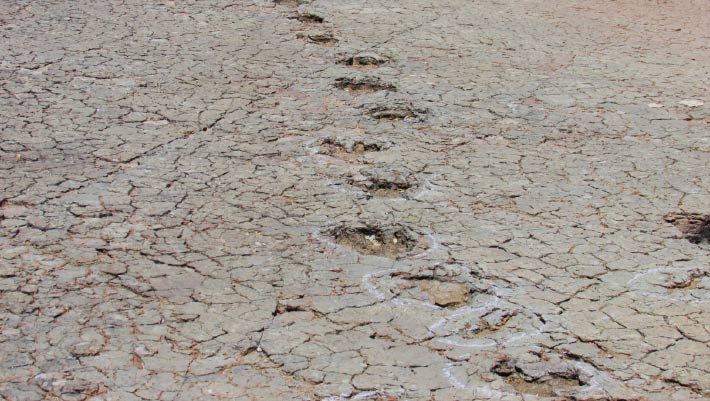A team of paleontologists led by Southern Methodist University has discovered more than 260 footprints of Early Cretaceous dinosaurs in Brazil and in Cameroon, showing where land-dwelling dinosaurs were last able to freely cross between South America and Africa millions of years ago before the two continents split apart.
A footprint of theropod dinosaur from Sousa Basin, northeastern Brazil. Image credit: Ismar de Souza Carvalho / SMU.
Africa and South America started to split around 140 million years ago, causing gashes in Earth’s crust called rifts to open up along pre-existing weaknesses.
As the tectonic plates beneath South America and Africa moved apart, magma from the Earth’s mantle rose to the surface, creating new oceanic crust as the continents moved away from each other.
And eventually, the South Atlantic Ocean filled the void between these two continents.
Signs of some of those major events were evident between both locations where the 120-million-year-old footprints of three-toed theropods, sauropods and ornithischian dinosaurs were found by Southern Methodist University paleontologist Louis Jacobs and his colleagues.
“We determined that in terms of age, these footprints were similar,” Dr. Jacobs said.
“In their geological and plate tectonic contexts, they were also similar. In terms of their shapes, they are almost identical.”
A footprint of theropod dinosaur from the Koum Basin in northern Cameroon. Image credit: Ismar de Souza Carvalho / SMU.
The researchers found the fossilized footprints in the Borborema region in the northeast part of Brazil and the Koum Basin in northern Cameroon — more than 6,000 km (3,700 miles) away from each other.
“The dinosaurs made the tracks 120 million years ago on a single supercontinent known as Gondwana — which broke off from the larger landmass of Pangea,” Dr. Jacobs said.
“One of the youngest and narrowest geological connections between Africa and South America was the elbow of northeastern Brazil nestled against what is now the coast of Cameroon along the Gulf of Guinea.”
“The two continents were continuous along that narrow stretch, so that animals on either side of that connection could potentially move across it.”
“Before the continental connection between Africa and South America was severed, rivers flowed and lakes formed in the basins,” he said.
“Plants fed the herbivores and supported a food chain. Muddy sediments left by the rivers and lakes contain dinosaur footprints, including those of meat-eaters, documenting that these river valleys could provide specific avenues for life to travel across the continents 120 million years age.”
_____
This article is based on a press-release provided by Southern Methodist University.

